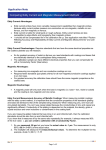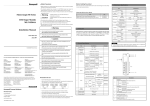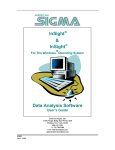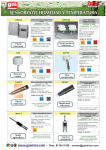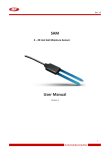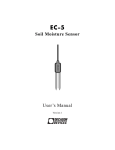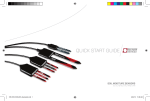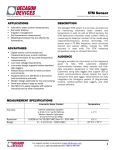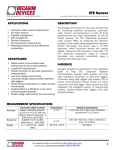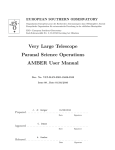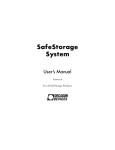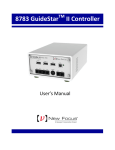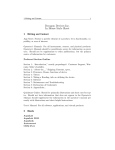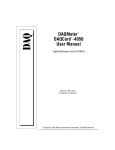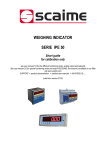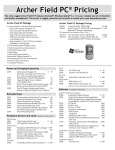Download Book MAS-1.book
Transcript
MAS-1 4-20 mA Soil Moisture Sensor User Manual Version 1 Decagon Devices, Inc. 2365 NE Hopkins Court Pullman WA 99163 (509)332-2756 www.decagon.com [email protected] ©2011 Decagon Devices, Inc. All rights reserved. MAS-1 Soil Moisture Sensor Contents 1. Introduction . . . . . . . . . . . . . . . . . . . . 1 Customer Service and Tech Support . . . . . . . 2 Warranty . . . . . . . . . . . . . . . . . . . . . . . . . . . . . 3 Seller’s Liability . . . . . . . . . . . . . . . . . . . . . . . 3 2. About the MAS-1 . . . . . . . . . . . . . . . 4 3. Integrating the MAS-1 . . . . . . . . . . . . . 5 Wiring . . . . . . . . . . . . . . . . . . . . . . . . . . . . . . . 6 Conventional (PLC) . . . . . . . . . . . . . . . . . . 6 Non-Conventional . . . . . . . . . . . . . . . . . . . 6 Testing the Sensor . . . . . . . . . . . . . . . . . . . . . 9 4. Installing the MAS-1 . . . . . . . . . . . . 10 Procedure . . . . . . . . . . . . . . . . . . . . . . . . . . . 10 Orientation . . . . . . . . . . . . . . . . . . . . . . . . . . 11 Removing the Sensor . . . . . . . . . . . . . . . . . . 11 5. Calibration . . . . . . . . . . . . . . . . . . . . . 12 Mineral Soils . . . . . . . . . . . . . . . . . . . . . . . . . 12 Potting Soil/Peat . . . . . . . . . . . . . . . . . . . . . 13 Rock Wool . . . . . . . . . . . . . . . . . . . . . . . . . . 13 6. Troubleshooting . . . . . . . . . . . . . . . . 14 Index . . . . . . . . . . . . . . . . . . . . . . . . . . . 15 i MAS-1 Soil Moisture Sensor ii MAS-1 Soil Moisture Sensor 1. Introduction 1. Introduction Thank you for choosing the MAS-1 4-20 mA Soil Moisture Sensor. These innovative sensors will enable you to monitor soil moisture accurately and affordably with a standard 2wire, 4-20 mA analog interface for use with many data acquisition and control systems. The MAS-1 can not be used with the standard Decagon data loggers. Specifications Electrical Interface: Standard 4-20 mA, 2-wire analog transmitter Supply voltage: 7-32 VDC continuous Output current: 4-20 mA Overvoltage protection: Yes Reverse polarity protection: Yes Settling time: 4 seconds Wiring: Red wire: (+) supply Black wire: (-) output Shield: Not connected Measurement Type: Volumetric water content (VWC) Range: 0-50% VWC typical Resolution: Depends on current measurement (data acquisition) device Accuracy: ± 4 % VWC with factory mineral soil calibration in a typical mineral soil; ± 1-2% VWC with medium-specific calibration in most porous medium 1 MAS-1 Soil Moisture Sensor 1. Introduction Output: 4-20 mA current proportional to VWC Sensor measurement interval: 1 second Operating Environment Temperature: -40 to 50 °C Physical Properties Dimensions: 8.9 cm x 1.8 cm x 0.7 cm Cable: 2 m, 3 wire (22 AWG tinned Red and Black wire, 24 AWG tinned bare wire); (Custom cable length available upon request) Customer Service and Tech Support When contacting us via fax or email, include the following information: Your MAS-1’s serial number (found on the white cable lable), your name, address, phone and fax number, and a description of your problem. Phone: Call Monday - Friday, between 8 a.m. and 5 p.m. PST. US and Canada (toll-free): 1-800-755-2751 Outside of the US and Canada: (509) 332-2756 Fax: (509) 332-5158 E-mail: [email protected]. NOTE: If you purchased your MAS-1 through a distributor, please contact them for assistance. 2 MAS-1 Soil Moisture Sensor 1. Introduction Warranty The MAS-1 has a one year warranty on parts and labor. It is activated upon the arrival of the instrument at your location. Seller’s Liability Seller warrants new equipment of its own manufacture against defective workmanship and materials for a period of one year from date of receipt of equipment (the results of ordinary wear and tear, neglect, misuse, accident and excessive deterioration due to corrosion from any cause are not to be considered a defect); but Seller’s liability for defective parts shall in no event exceed the furnishing of replacement parts F.O.B. the factory where originally manufactured. Material and equipment covered hereby which is not manufactured by Seller shall be covered only by the warranty of its manufacturer. Seller shall not be liable to Buyer for loss, damage or injuries to persons (including death), or to property or things of whatsoever kind (including, but not without limitation, loss of anticipated profits), occasioned by or arising out of the installation, operation, use, misuse, nonuse, repair, or replacement of said material and equipment, or out of the use of any method or process for which the same may be employed. The use of this equipment constitutes Buyer’s acceptance of the terms set forth in this warranty. There are no understandings, representations, or warranties of any kind, express, implied, statutory or otherwise (including, but without limitation, the implied warranties of merchantability and fitness for a particular purpose), not expressly set forth herein. 3 MAS-1 Soil Moisture Sensor 2. About the MAS-1 2. About the MAS-1 The MAS-1 measures the dielectric constant of the soil in order to find its volumetric water content. Since the dielectric constant of water is much higher than that of air or soil minerals, the dielectric constant of the soil is a sensitive measure of water content. The MAS-1 supplies a 70 MHz oscillating wave to the sensor prongs that induces an electromagnetic field in the medium (soil) surrounding the sensor. The charging and discharging of the sensor is controlled by the dielectric of the surrounding soil. A microprocessor on the MAS-1 measures the charging of the sensor, and therefore the dielectric constant of the soil which is related to the water content of the soil. The microprocessor makes a dielectric measurement and updates the trasnmitted current once per second. The transmitted 4-20 mA current can be converted to the water content of the soil using a simple calibration function. The MAS-1 was designed to be used with standard 4-20 mA controllers and monitoring systems. It cannot be used with Decagon logging systems. For more information about using Decagon logging systems please contact Decagon’s customer support representatives. 4 MAS-1 Soil Moisture Sensor 3. Integrating the MAS-1 3. Integrating the MAS-1 A 4-20mA system generally consists of a sensor, a transmitter, a power supply, and a device to read the current being transmitted through the current loop. The MAS-1 is an integrated sensor and 4-20mA transmitter. When the MAS-1 is powered by the Power Supply, it transmits a current though the loop that is proportional to the soil dielectric permittivity and therefore the soil volumetric water content. In Figure 1, the current loop is shown by the dotted line labeled I=420mA. The arrows indicate the direction of the current. Figure 1 - 4-20mA current loop diagram The MAS-1 uses a microcontroller to regulate the interval at which it takes measurements. It takes one second from the time it is powered up to take its first measurement and transmit current though the loop. The trasnmitted current will reach a stable value within four seconds of power up. After the initial four second startup, measurements are taken every one second, while the current in the loop is continuously maintained. Since the measurement intervals are controlled 5 MAS-1 Soil Moisture Sensor 3. Integrating the MAS-1 by the MAS-1 itself, there is no need to pulse the excitation voltage. A constant supply voltage should be applied in order for the MAS-1 to function as it is designed. Wiring Conventional (PLC) A Programmable Logic Controller (PLC) is typically used to read the current transmitted from the MAS-1. The red wire (see Figure 2) of the MAS-1 is connected to a voltage output terminal that is able to supply 7-32 VDC. The black wire is connected to an input terminal that is capable of accepting a current input ranging from 4 mA to 20 mA. Figure 2 - Typical wiring connection Non-Conventional When using a device, such as a data logger, that does not have an input capable of measuring current, a pickoff resistor can be used as shown in Figure 3. Assuming that the Single Ended Input has an input impedance, or resistance, much larger that of RVolt, then all of the current in the 4-20 mA loop passes through RVolt. If the data logger can measure 6 MAS-1 Soil Moisture Sensor 3. Integrating the MAS-1 the voltage drop over the RVolt, then the current can be calculated as I = Vmeasured / RVolt (1) Where I (mA) is the 4-20 mA current, RVolt (ohms) is the resistance of the pickoff resistor, and Vmeasured (mV) is the voltage drop over RVolt. Figure 3 - Wiring connection for devices without current inputs The optional 100uF capacitor shown in parallel with the RVolt reduces measurement noise. It should have a voltage rating higher than the largest supply voltage and be sure to observe correct polarity. The value of RVolt is limited by the amount of impedance that the MAS-1 circuitry can drive current through. The values in Table 1 represent the maximum load that the MAS-1 can drive at the given supply voltage. Equation (2) was derived from the values in Table 1, which were obtained through direct measurement. Vin represents the supply voltage to the MAS-1, which ranges from 7-32 VDC. RVolt Max 7 MAS-1 Soil Moisture Sensor 3. Integrating the MAS-1 is the maximum resistor value that can be used to convert the current to a voltage. If RVolt is greater than RVolt Max, the output current will decrease, which will cause the MAS-1 to output incorrect readings. Equation (2) can be used to determine the maximum value for RVolt. RVolt Max = 58.651(Vin) - 355.76 Supply Voltage 12 V 24 V 32 V (2) Load 340 1.072 K 1.509 K Table 1 – Maximum resistance values for RVolt at specified voltages The MAS-1 sensor has several advantages over voltage-output sensors, even for voltage-input data loggers. • • • • • The MAS-1 supply voltage doesn’t need to be regulated for the sensor to work properly; it can be any value between 7 and 32 volts, without affecting sensor output. When using a current-based sensor like the MAS-1, the signal is not affected by electrical resistance in the cable, so the sensor output is not affected by cable length or wire gauge. The MAS-1 requires only two conductors, so long lines are both lower in noise and less expensive. With the MAS-1sensor the source impedance is small, and a current loop is highly immune to noise on the line. Measured voltage can be tailored to a particular data acquisition system simply by adjusting the value of RVolt. A typical application might be to use a MAS-1 8 MAS-1 Soil Moisture Sensor 3. Integrating the MAS-1 with a 12 volt supply and a RVolt value of 100 ohms. The output voltage range is the product of the current and the resistance (Equation (1)), so for 4-20 mA it would be 0.4 to 2 volts. Testing the Sensor After integrating the MAS-1 into your PLC or other data acquisition system, it is always a good idea to test the sensor output to verify that it is functioning correctly with your system. Two convenient test conditions are having the sensor surrounded by air and water. To test in air, suspend the sensor from the cable, making sure that it is at least 6 inches from any object. To test in water, place the sensor in a bucket of tap water (do not use de-ionized or distilled water). The entire sensor (prongs + black plastic electronics portion) should be immersed in water, and should be at least 2 inches from any container surface. Under these conditions, the sensor should transmit in the following ranges (approximate): Air: 3.4 to 4.7 mA Tap water: 18.1 to 22.4 mA 9 MAS-1 Soil Moisture Sensor 4. Installing the MAS-1 4. Installing the MAS-1 When selecting a site for installation, it is important to understand that the soil adjacent to the sensor surface has the strongest influence on the sensor reading and that the sensor measures the volumetric water content. Therefore any air gaps or excessive soil compaction around the sensor can profoundly influence the readings. Also, do not install the sensors adjacent to large metal objects such as metal poles or stakes. This can attenuate the sensor's electromagnetic field and adversely affect sensor readings. Because the MAS-1 has gaps between its prongs, it is also important to consider the size of the media you are inserting the sensor into. It is possible to get sticks, bark, roots or other material stuck between the sensor prongs, which will adversely affect readings. Finally, be careful when inserting the sensors into dense soil, as the prongs will break if excessive sideways force is used when pushing them in. Procedure 1. The MAS-1 sensor was designed for easy installation into the soil. After digging a hole to the desired depth, push the prongs on the sensor into undisturbed soil at the bottom of the hole or into the sidewall of the hole. Make sure that the prongs are buried completely up to the black overmolding. The sensor may be difficult to insert into extremely compact or dry soil. If you have difficulty inserting the sensor, try loosening the soil somewhat or wetting the soil. Never pound it in! 10 MAS-1 Soil Moisture Sensor 4. Installing the MAS-1 2. Carefully backfill the hole to match the bulk density of the surrounding soil. Be careful to not over stress the cable or overmold by bending when installing the sensor. Orientation The sensor can be oriented in any direction. However, orienting the flat side perpendicular to the surface of the soil will minimize effects on downward water movement. Removing the Sensor When removing the sensor from the soil, do not pull it out of the soil by the cable! Doing so may break internal connections and make the sensor unusable. 11 MAS-1 Soil Moisture Sensor 5. Calibration 5. Calibration The current transmitted by the MAS-1 is proportional to the dielectric permittivity of the medium surrounding the sensor, and therefore its volumetric water content (VWC) of the medium. The VWC is calculated by applying a calibration equation to the current transmitted by the MAS-1. The following are generic calibration equations for common growth media. Applying these equations will generally result in accuracy of ± 4% VWC as long as the electrical conductivity of the medium is less than 8 dS/m. If you wish to use the MAS-1 in a medium that isn't listed below, if you need better than ± 4% accuracy, or if you are working in a high salinity material, then you should develop a custom calibration for your particular medium. See www.decagon.com for step-by-step instructions on developing a custom calibration. Decagon can also develop a custom calibration for your medium; contact Decagon for more details on the calibration service. Mineral Soils A single calibration equation will generally result in good accuracy for all mineral soil types with electrical conductivity < 8 dS/m. VWC is given by: VWC = 0.00328 * mA2 - 0.0244 * mA - 0.00565 If your data aquisition system isn’t capable of higher order mathematical operations, the mineral soil calibration can be 12 MAS-1 Soil Moisture Sensor 5. Calibration approximated by the following linear model. This will result in slightly worse accuracy at low VWC, with errors becoming large above 35% VWC. VWC= 0.0479 * mA - 0.391 Potting Soil/Peat The following equation can be used to convert MAS-1 transmitted current into VWC in potting soil and peat potting mixes. Please note that different potting soil types are quite variable, so this calibration equation may not result in good accuracy in your particular mix (although precision should still be good). We recommend a custom calibration for best accuracy when using the MAS-1 in potting soils. VWC = 0.00531 *e(0.29*mA) Rock Wool The MAS-1 was calibrated in Groden Expert™ rockwool at several eletrical conductivities. VWC can be calculated as: VWC = 0.00446 * mA2 - 0.0359 * mA + 0.0741 13 MAS-1 Soil Moisture Sensor 6. Troubleshooting 6. Troubleshooting If you encounter problems with the MAS-1, they will usually be caused by one of two situations • If the MAS-1 readings in air and/or water are outside the ranges given in the Testing the Sensor section, then there is likely a problem with the connection to the PLC or other data acquisition system. Check the wiring and check to make sure that the supply voltage is in the specified range. • If the MAS-1 is reading a negative value for VWC while it is inserted into the soil, make sure that you have good sensor-to-soil contact. When inserted, the MAS-1 should be completely covered up past the black overmolding. Removing and re-installing the full length of the sensor with good sensor-to-soil contact should remedy this problem. If problems persist, contact Decagon for assistance. 14 MAS-1 Soil Moisture Sensor Index Index C Calibration 12 Contact information 2 D Dielectric constant 4 E E-mail 2 F Fax Number 2 Functional testing 9 I Installation 10 Integration 5 O Orientation 11 S Seller’s liability 3 Specifications 1 T Telephone number 2 Troubleshooting 14 15 MAS-1 Soil Moisture Sensor Index W Warranty 3 Wiring 6 16




















